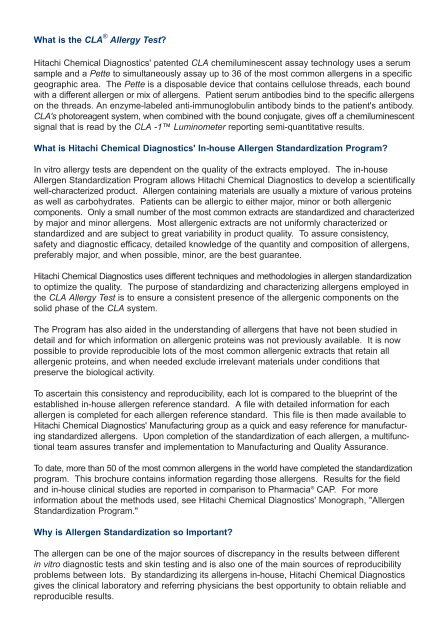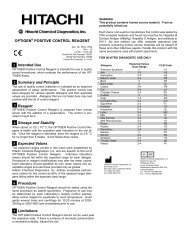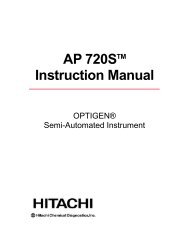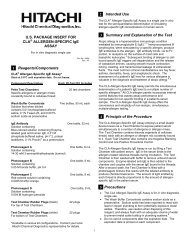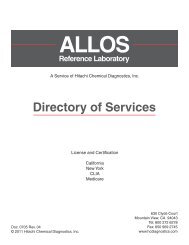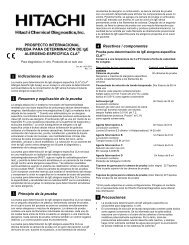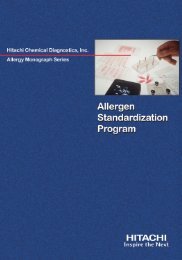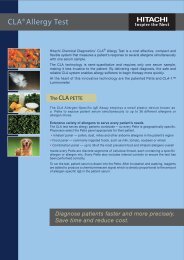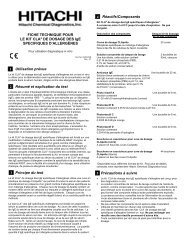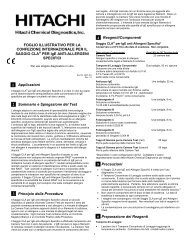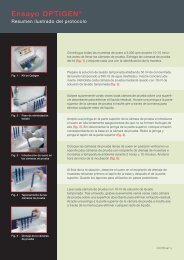Allergen Resource Guide - Hitachi Chemical Diagnostics
Allergen Resource Guide - Hitachi Chemical Diagnostics
Allergen Resource Guide - Hitachi Chemical Diagnostics
Create successful ePaper yourself
Turn your PDF publications into a flip-book with our unique Google optimized e-Paper software.
What is the CLA ® Allergy Test?<br />
<strong>Hitachi</strong> <strong>Chemical</strong> <strong>Diagnostics</strong>' patented CLA chemiluminescent assay technology uses a serum<br />
sample and a Pette to simultaneously assay up to 36 of the most common allergens in a specific<br />
geographic area. The Pette is a disposable device that contains cellulose threads, each bound<br />
with a different allergen or mix of allergens. Patient serum antibodies bind to the specific allergens<br />
on the threads. An enzyme-labeled anti-immunoglobulin antibody binds to the patient's antibody.<br />
CLA's photoreagent system, when combined with the bound conjugate, gives off a chemiluminescent<br />
signal that is read by the CLA -1 Luminometer reporting semi-quantitative results.<br />
What is <strong>Hitachi</strong> <strong>Chemical</strong> <strong>Diagnostics</strong>' In-house <strong>Allergen</strong> Standardization Program?<br />
In vitro allergy tests are dependent on the quality of the extracts employed. The in-house<br />
<strong>Allergen</strong> Standardization Program allows <strong>Hitachi</strong> <strong>Chemical</strong> <strong>Diagnostics</strong> to develop a scientifically<br />
well-characterized product. <strong>Allergen</strong> containing materials are usually a mixture of various proteins<br />
as well as carbohydrates. Patients can be allergic to either major, minor or both allergenic<br />
components. Only a small number of the most common extracts are standardized and characterized<br />
by major and minor allergens. Most allergenic extracts are not uniformly characterized or<br />
standardized and are subject to great variability in product quality. To assure consistency,<br />
safety and diagnostic efficacy, detailed knowledge of the quantity and composition of allergens,<br />
preferably major, and when possible, minor, are the best guarantee.<br />
<strong>Hitachi</strong> <strong>Chemical</strong> <strong>Diagnostics</strong> uses different techniques and methodologies in allergen standardization<br />
to optimize the quality. The purpose of standardizing and characterizing allergens employed in<br />
the CLA Allergy Test is to ensure a consistent presence of the allergenic components on the<br />
solid phase of the CLA system.<br />
The Program has also aided in the understanding of allergens that have not been studied in<br />
detail and for which information on allergenic proteins was not previously available. It is now<br />
possible to provide reproducible lots of the most common allergenic extracts that retain all<br />
allergenic proteins, and when needed exclude irrelevant materials under conditions that<br />
preserve the biological activity.<br />
To ascertain this consistency and reproducibility, each lot is compared to the blueprint of the<br />
established in-house allergen reference standard. A file with detailed information for each<br />
allergen is completed for each allergen reference standard. This file is then made available to<br />
<strong>Hitachi</strong> <strong>Chemical</strong> <strong>Diagnostics</strong>' Manufacturing group as a quick and easy reference for manufacturing<br />
standardized allergens. Upon completion of the standardization of each allergen, a multifunctional<br />
team assures transfer and implementation to Manufacturing and Quality Assurance.<br />
To date, more than 50 of the most common allergens in the world have completed the standardization<br />
program. This brochure contains information regarding those allergens. Results for the field<br />
and in-house clinical studies are reported in comparison to Pharmacia ® CAP. For more<br />
information about the methods used, see <strong>Hitachi</strong> <strong>Chemical</strong> <strong>Diagnostics</strong>' Monograph, "<strong>Allergen</strong><br />
Standardization Program."<br />
Why is <strong>Allergen</strong> Standardization so Important?<br />
The allergen can be one of the major sources of discrepancy in the results between different<br />
in vitro diagnostic tests and skin testing and is also one of the main sources of reproducibility<br />
problems between lots. By standardizing its allergens in-house, <strong>Hitachi</strong> <strong>Chemical</strong> <strong>Diagnostics</strong><br />
gives the clinical laboratory and referring physicians the best opportunity to obtain reliable and<br />
reproducible results.


